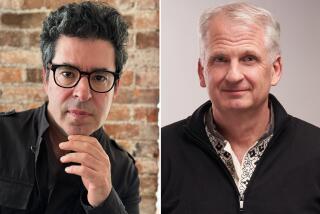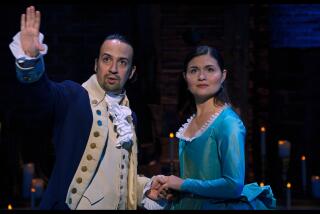Adaptation of 1962’s ‘Man in the High Castle’ provides timely view of freedom’s cost
- Share via
It has taken decades for Philip K. Dick’s 1962 political dystopia, “The Man in the High Castle,” to be adapted to the screen. Decades of political, cultural and economic change here and abroad, decades in which enemies have become friends and a new threat, a different type of warfare, has emerged.
Yet there could not be a better time for Amazon to debut Frank Spotnitz’s serialized vision of “The Man in the High Castle.” As anger and fear sparked by the recent terrorist attacks in Paris cause many to weigh the essentials of democracy against the need for safety, this series offers a carefully crafted, admirably objective and chillingly prescient vision of American fascism.
“The Man in the High Castle” envisions a 1960s America in which the Axis powers have won World War II. Or rather, Germany and Japan have won World War II — Italy does not appear to have a presence in the new nation formerly known as the United States of America, which is now divided into the Greater Nazi Reich and the Japanese Pacific States. (The territories are separated by a “Neutral Zone” that runs through the western states including Colorado and Wyoming.)
SIGN UP for the free Indie Focus movies newsletter >>
The story revolves around a disparate group of characters brought together by a set of banned film reels that depict (in actual historic footage) images of an Allied victory. American rebels are trying to get copies of the film, called “The Grasshopper Lies Heavy,” to the mysterious man in the high castle while the forces of oppression seek to confiscate and presumably destroy them.
Whether the films are proof of an alternate universe or simply an attempt to inspire hope does not appear to be the point — it is the actions they spark that the series follows.

Ridley Scott, who brought Dick’s’ “Blade Runner” to the big screen, serves as executive producer, which is made instantly and abundantly clear. Like all good alternative universe stories — be they futuristic, post-apocalyptic or science fiction — “The Man in the High Castle” is initially more concerned with dramatic imagery than character introduction.
The mournfully sinister rendition of “Edelweiss” that accompanies opening credits, the sight of the swastika emblazoned on the buildings in Times Square and the Japanese flag above the storefronts of San Francisco, the overwhelming military presence in both cities, are all breathtaking in both the artistic and horrifying sense.
Because beneath these outrageous symbols, daily life continues. The Allies lost, fascism won and yet life continues. Millions of American Jews and political dissidents have been slaughtered, the old and infirm are regularly incinerated, the press has become a mouthpiece, the populace is controlled by fear and identity papers, and yet life continues.
Yet as even Dick’s dystopian map makes clear, the United States is too vast to be overthrown by invasion or even the bombing of its capital; internal sympathy and collaboration on a massive scale is required and provided.
Hitler, we learn, is ailing, and though there is much discussion over who will succeed him and what that will mean, the chief villain of the Reich is not German. Obergruppenführer John Smith (Rufus Sewell) may have the hooded eyes, frozen mien and casual sadism of a Hollywood Nazi, but he is as American as “Mad Men’s” Don Draper, with a similar compartmentalized life. In the city, he schemes to quash any potential rebellion; in his lovely suburban home, he acts as loving husband and father.
On the West Coast, the Japanese are more visible but less directly brutal. Juliana Crane (Alexa Davalos), the story’s initial hero, studies and teaches aikido and lives with her boyfriend, Frank (Rupert Evans), a machinist who designs jewelry despite the regimes’ attitudes toward “degenerate art.” Their lives are not ideal, but they do not rebel or even question until Juliana’s sister, Trudy, is killed while trying to smuggle a copy of “The Grasshopper Lies Heavy” out of the city.
Her death puts Juliana and eventually Frank on a course of realization that can lead only to rebellion.
Spotnitz takes his time in all things, and the slow pace of the first six episodes of “The Man in the High Castle” often work against the agitated drama of its imagery. A narrative involving Joe Blake (Luke Kleintank), a young man with shifting allegiances, seems at times unnecessarily oblique.
The formidable Cary-Hiroyuki Tagawa plays a Japanese trade minister attempting to keep Germany from breaking its agreement with Japan, and while he and his character are two of the series’ strongest elements, his story too is often difficult to follow.
Some of the initial choppiness is because of logistics — in serializing it, Spotnitz has made many changes to Dick’s original tale. But there is method too in some of the maddening detours.
“The Man in the High Castle” is built to fly in the face of both our artistic and patriotic expectations. It doesn’t move like a hero tale — this isn’t “Hogan’s Heroes” or a serialization of “Independence Day” — because heroism is not the default setting of its characters, or, indeed, of the country in which it is set. Spotnitz doesn’t just humanize the demonic — by Episode 6, Nazi swine John Smith has become far less cartoonish — he demonizes the human.
There are few who would openly disagree with Edmund Burke’s famous proclamation that the only thing necessary for the triumph of evil is for good men to do nothing, but actions, and inactions, matter far more than platitudes.
With words that should resonate deeply with viewers at this time, America’s surrender to fascism is repeatedly explained as a necessity to end war, to preserve peace. But as “The Man in the High Castle” reminds us in exquisite and unsettlingly detail, freedom is never safe and only rarely is it peaceful.
-----------------------------
‘The Man in the High Castle’
Where: Amazon Prime
When: Anytime, starting Friday
Rating: TV-MA (may be unsuitable for children under age 17)
ALSO:
Marvel’s astounding ‘Jessica Jones’ rewrites the definition of superhuman
Far-fetched ‘Flesh and Bone’ on Starz aims for grit, which means lots of sex
‘The Art of More’ on Crackle might leave a viewer caring less
More to Read
The complete guide to home viewing
Get Screen Gab for everything about the TV shows and streaming movies everyone’s talking about.
You may occasionally receive promotional content from the Los Angeles Times.







